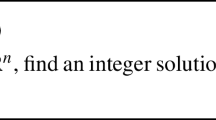Abstract
The Angular Constrained Minimum Spanning Tree Problem (\(\alpha \)-MSTP) is defined in terms of a complete undirected graph \(G=(V,E)\) and an angle \(\alpha \in (0,2\pi ]\). Vertices of G define points in the Euclidean plane while edges, the line segments connecting them, are weighted by the Euclidean distance between their endpoints. A spanning tree is an \(\alpha \)-spanning tree (\(\alpha \)-ST) of G if, for any \(i \in V\), the smallest angle that encloses all line segments corresponding to its i-incident edges does not exceed \(\alpha \). \(\alpha \)-MSTP consists in finding an \(\alpha \)-ST with the least weight. In this work, we discuss families of \(\alpha \)-MSTP valid inequalities. One of them is a lifting of existing angular constraints found in the literature and the others come from the Stable Set polytope, a structure behind \(\alpha \)-STs disclosed here. We show that despite being already satisfied by the previously strongest known formulation, \({\mathcal {F}}_{xy}\), these lifted angular constraints are capable of strengthening another existing \(\alpha \)-MSTP model so that both become equally strong, at least for the instances tested here. Inequalities from the Stable Set polytope improve the best known Linear Programming Relaxation (LPRs) bounds by about 1.6%, on average, for the hardest instances of the problem. Additionally, we indicate how formulation \({\mathcal {F}}_{xy}\) can be more effectively used in Branch-and-cut (BC) algorithms, by reducing the number of variables explicitly enforced to be integer constrained and by eliminating constraints that do not change the quality of its LPR bounds. Extensive computational experiments conducted here suggest that the combination of the ideas above allows us to redefine the best performing \(\alpha \)-MSTP algorithms, for almost the entire spectrum of \(\alpha \) values, the exception being the easy instances, those with \(\alpha \ge \frac{2\pi }{3}\). In particular, for the hardest ones (corresponding to \(\alpha \in \{\frac{\pi }{2}, \frac{\pi }{3},\frac{2\pi }{5}\}\)) that could be solved to proven optimality, the best BC algorithm suggested here improves on average CPU times by factors of up to 5, on average.




Similar content being viewed by others
References
Ackerman E, Gelander T, Pinchasi R (2013) Ice-creams and wedge graphs. Comput Geom 46:213–218
Aloupis G, Damian M, Flatland R, Korman M, Ozkan O, Rappaport D, Wuhrer S (2013) Establishing strong connectivity using optimal radius half-disk antennas. Comput Geom 46(3):328–339
Aschner R, Katz MJ (2017) Bounded-angle spanning tree: modeling networks with angular constraints. Algorithmica 77:349–373
Aschner R, Katz MJ, Morgenstern G (2013) Symmetric connectivity with directional antennas. Comput Geom 46(9):1017–1026
Atamtürk A, Nemhauser GL, Savesbergh MWP (2000) Conflict graphs in solving integer programming problems. Eur J Oper Res 121:40–55
Bicalho L, da Cunha AS, Lucena A (2016) Branch-and-cut-and-price algorithms for the degree constrained minimum spanning tree problem. Comput Optim Appl 63:755–792
Caragiannis I, Kaklamanis C, Kranakis E, Krizanc D, Wiese A (2008) Communication in wireless networks with directional antennas. In: Heide FMAD (ed) Proceedings of the twentieth annual symposium on parallelism in algorithms and architectures. Association for Computing Machinery, pp 344–351
Carmin P, Katz MJ, Lotker Z, Rosén A (2011) Connectivity guarantees for wireless networks with directional antennas. Comput Geom 44:477–485
da Cunha AS, Lucena A (2019) Modeling and solving the angular constrained minimum spanning tree problem. Comput Oper Res 112:104775
Dai HN, Ng KW, Li M, Wu MY (2013) An overview of using directional antennas in wireless networks. Int J Commun Syst 26(4):413–448
Damian M, Flatland R (2013) Spanning properties of graphs induced by directional antennas. Discrete Math Algorithms Appl 05(03):1350008
Dolan ED, Moré JJ (2002) Benchmark optimization software with performance profiles. Math Program 91(2):201–213
Edmonds J (1971) Matroids and the greedy algorithm. Math Program 1(1):127–136
FICO XPRESS: XPRESS mixed integer optimization package, release 8.4 (2017)
Nemhauser G, Trotter L (1974) Properties of vertex packing and independence system polyhedra. Math Program 6:48–61
Padberg M (1973) On the facial structure of set packing polyhedra. Math Program 5:199–215
Padberg MW, Wolsey LA (1983) Trees and cuts. Ann Discrete Math 17:511–517
Rebennack S, Reinelt G, Pardalos PM (2012) A tutorial on branch and cut algorithms for the maximum stable set problem. Int Trans Oper Res 19:161–199
Reinelt G (1991) TSPLIB: a traveling salesman problem library. ORSA J Comput 3(4):376–384
Tran TH (2017) Connectivity problems in wireless sensor networks with directional antennas. Ph.D. thesis, The University of Texas at Dallas, Computer Science Department
Tran T, Huynh DT (2020) The complexity of symmetric connectivity in directional wireless sensor networks. J Comb Optim 39(3):662–686
Tran T, An MK, Huynh DT (2017) Symmetric connectivity in wsns equipped with multiple directional antennas. In: 2017 international conference on computing, networking and communications (ICNC), pp 609–614
Yu Z, Teng J, Bai X, Xuan D, Jia W (2014) Connected coverage in wireless networks with directional antennas. ACM Trans Sens Netw 10(3):51:1-51:28
Acknowledgements
This research was partially funded by Conselho Nacional de Desenvolvimento Científico e Tecnológico (CNPq Grant 303928/2018-2) and Fundação de Amparo à Pesquisa do Estado de Minas Gerais (FAPEMIG Grant CEX - PPM-00164/17)
Author information
Authors and Affiliations
Corresponding author
Additional information
Publisher's Note
Springer Nature remains neutral with regard to jurisdictional claims in published maps and institutional affiliations.
Rights and permissions
About this article
Cite this article
da Cunha, A.S. Improved formulations and branch-and-cut algorithms for the angular constrained minimum spanning tree problem. J Comb Optim 44, 379–413 (2022). https://doi.org/10.1007/s10878-021-00835-w
Accepted:
Published:
Issue Date:
DOI: https://doi.org/10.1007/s10878-021-00835-w




